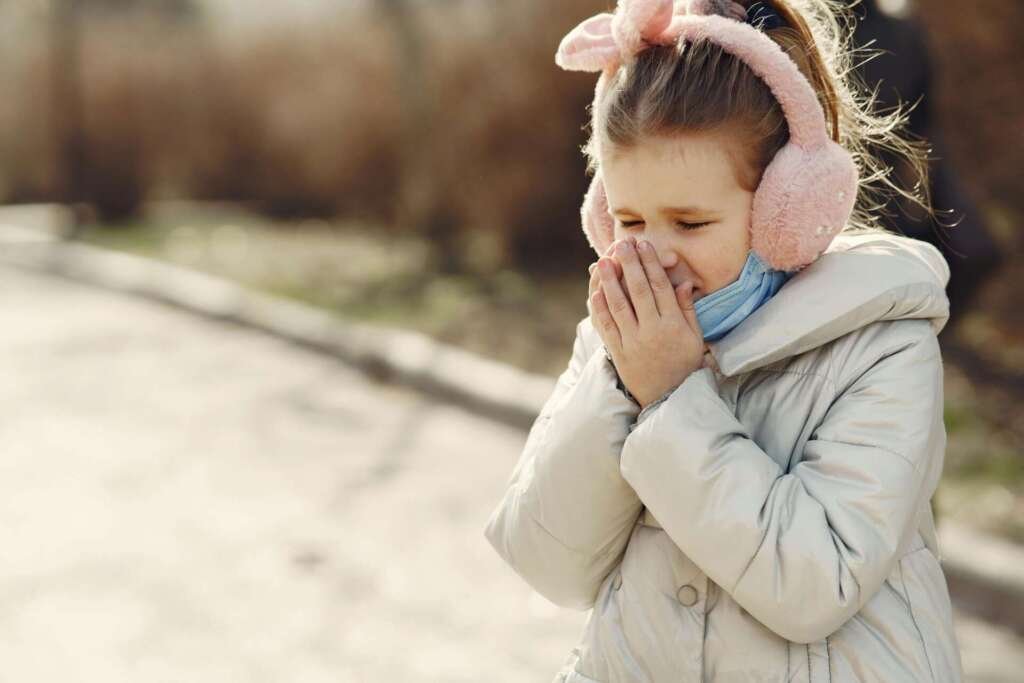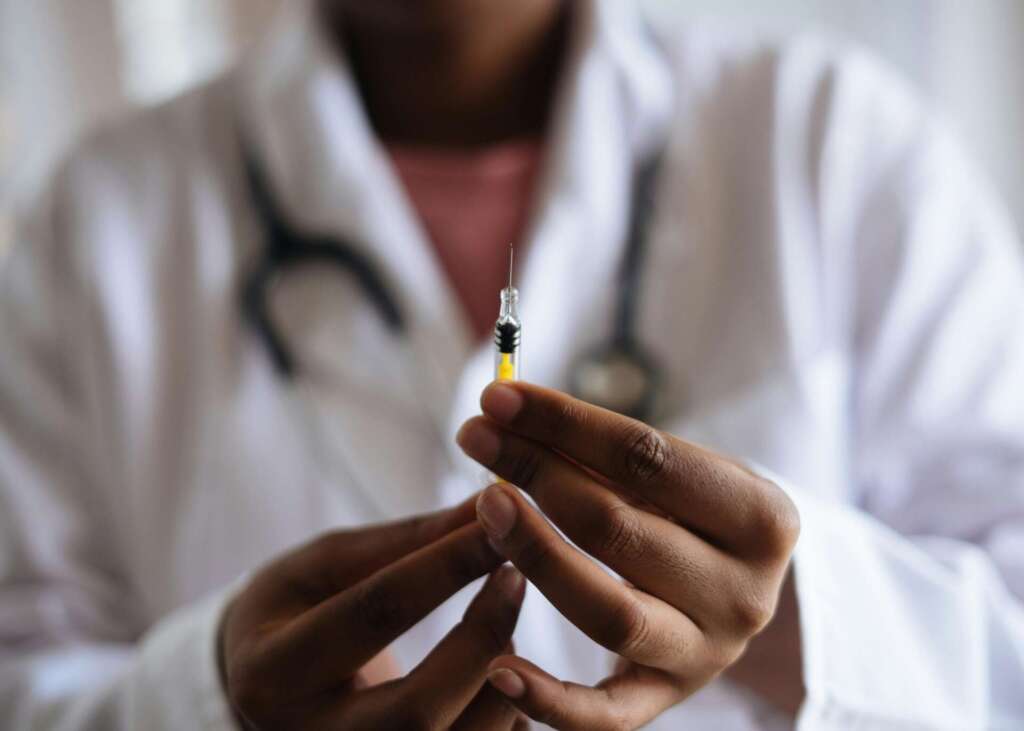Whooping cough, a disease that was once nearly eradicated thanks to effective vaccination programs, is making an alarming comeback. This highly contagious respiratory disease that causes severe coughing, poses a renewed threat to the most vulnerable among us, particularly young children and infants, and those with weakened immune systems. Despite medical advancements, recent outbreaks underscore the importance of us all being aware of what the disease is, how its symptoms display and how we can prevent it.

What is Whooping Cough (Pertussis)?
Whooping cough, also known as pertussis, is a highly contagious respiratory disease. It is characterized by severe coughing fits followed by a high-pitched “whoop” sound as the person breathes in.
Whooping cough is caused by a bacterium known as Bordetella parapertussis. It attaches to the cilia lining the upper respiratory tract and releases toxins that damage the cilia and cause inflammation. This leads to the coughing spells which are characteristic of whooping cough.
How is Whooping Cough Transmitted?
When an infected person coughs or sneezes, they release tiny droplets in the air. These droplets contain the bacterium that causes whooping cough. People nearby then breathe these droplets in, leading to infection. Close contact, such as living in the same household or sharing a confined space, increases the risk of infection.
Whooping cough is most contagious during the early stages, often before severe coughing spells begin, making it difficult to prevent its spread. Babies, who are not fully vaccinated, and people with weakened immune systems are at the greatest risk of contracting and experiencing severe complications from whooping cough.
Signs and Symptoms of Whooping Cough (Pertussis)

Whooping cough progresses through three stages. An infected person will display different symptoms depending on their stage.
1. Catarrhal Stage
This stage lasts about 1-2 weeks. Symptoms are mild and resemble those of a common cold – including runny nose, sneezing, low-grade fever, and a mild cough. This stage is the most contagious and often goes unrecognized as whooping cough.
2. Paroxysmal Stage
This stage lasts a few weeks, usually between 1-6 weeks, but it can last as long as 10 weeks. Symptoms of whooping cough during this stage are severe. They display as paroxysms.
What are paroxysms?
A paroxysmal cough is characterized by sudden, intense, and uncontrollable bouts of coughing that can leave the affected person gasping for breath. This type of cough is often associated with whooping cough, which manifests in severe, rapid coughing fits followed by a high-pitched “whoop” sound as the person breathes in. The coughing episodes occur multiple times daily and are often worse at night. They can be exhausting and may result in vomiting, fatigue, and, in some cases, interrupted breathing (apnea) in infants.
Paroxysmal cough can last for weeks and significantly disrupt daily activities and sleep. It is a hallmark symptom of pertussis but can also be seen in other respiratory conditions, such as asthma and chronic bronchitis.
3. Convalescent Stage
This stage lasts between 2-3 weeks. Symptoms will gradually improve, with a decrease in the severity and frequency of coughing fits. However, milder coughing episodes may persist for several months.
Complications of Whooping Cough (Pertussis)
Whooping cough can lead to severe complications, particularly in infants and young children. Complications include:
- Pneumonia: The most common complication caused by secondary bacterial infections.
- Apnea: Temporary cessation of breathing, which can be life-threatening in infants.
- Seizures: Resulting from acute coughing or hypoxia.
- Encephalopathy: A rare occurrence – serious brain damage due to lack of oxygen.
- Malnutrition and Dehydration: Due to vomiting and difficulty feeding during coughing fits.
Adults and teenagers can also experience complications such as rib fractures, abdominal hernias, and urinary incontinence (loss of bladder control) due to acute coughing.
How is Whooping Cough Diagnosed?

Diagnosis of whooping cough can be challenging, especially since its early stages display as cold like symptoms. A healthcare professional who suspects pertussis infection may conduct one or a combination of these tests to diagnose whooping cough:
1. Nasopharyngeal Swab
The doctor takes a swab from the back of the nose or throat and tests for the presence of the Bordetella pertussis bacterium through culture or polymerase chain reaction (PCR) testing. This test is most accurate during the early stages of the illness, preferably within the first 2 weeks.
2. Blood Tests
Your healthcare professional will collect a blood sample to measure antibody levels against pertussis bacteria. Rising antibody levels over time can indicate a recent infection.
3. Imaging Studies
In some cases, your doctor will order a chest X-ray to evaluate for complications such as pneumonia, especially if your symptoms are severe or if you are at increased risk of complications.
4. Clinical Evaluation
When laboratory testing is unavailable or inconclusive, healthcare providers might diagnose whooping cough based on clinical criteria. They will take a detailed medical history and conduct a physical exam. They will ask about symptoms, including the characteristic “whooping” sound, severe coughing fits, and recent exposure to individuals with confirmed or suspected whooping cough.
Treatment

Early treatment of whooping cough is crucial to reducing the severity and duration of its symptoms. It also helps to prevent the spread of the disease to others. The primary treatment options include:
Antibiotics
Healthcare professionals prescribe medications such as azithromycin, clarithromycin, or erythromycin to eliminate the Bordetella pertussis bacteria from the body. Early administration within the first stage of infection can significantly reduce the severity of symptoms and contagiousness.
Supportive Care
Ensuring adequate hydration and nutrition, managing fever, and maintaining a calm and stress-free environment to prevent exacerbation of coughing fits.
Hospitalization
In severe cases, particularly for infants and young children, hospitalization may be necessary to provide oxygen, intravenous fluids and close monitoring.
Prevention of Whooping Cough

The most effective way to prevent whooping cough is through vaccination. The vaccines used to protect against pertussis include:
- DTaP Vaccine: Given to children at 2, 4, 6, and 15-18 months, with a booster at 4-6 years of age. This vaccine protects against diphtheria, tetanus and pertussis.
- Tdap Vaccine: A booster given to adolescents at 11-12 years of age and adults who did not receive it as adolescents.
Vaccination process in the UK
In the UK, the whooping cough vaccine forms part of a 6-in-1 vaccine that protects against six different diseases. The vaccine is known as the DTaP/IPV/Hib/HepB vaccine. Babies will receive their first dose at 8 weeks of age. They will then receive the second dose at 12 weeks, and the third dose at 16 weeks of age.
Vaccination process in the USA
In the USA, the whooping cough vaccine is included in the DTaP vaccine. This vaccine also protects against diphtheria and tetanus. Babies will receive their first dose of the vaccine at 2 months of age. They will then receive the second dose at 4 months, the third at 6 months, and the fourth dose between 15 and 18 months of age. A fifth dose, called the booster dose, is given between 4 and 6 years of age.
Vaccination not only protects the individual but also contributes to herd immunity, reducing the overall prevalence of the disease in the community.
The Importance of Vaccination
Despite the availability of effective vaccines, outbreaks of whooping cough still occur. This is often due to waning immunity over time (this is why booster shots are not only necessary, but essential) and vaccine hesitancy.
Herd Immunity
Herd immunity occurs when a high percentage of the population is vaccinated. This reduces the overall spread of the disease. It also protects those who cannot be vaccinated, such as infants and individuals with certain medical conditions. Maintaining high vaccination rates is crucial to prevent outbreaks and protect vulnerable populations.
Can you get whooping cough if you’ve already received a vaccine?
The whooping cough vaccine is highly effective. However, it is still possible to get it even if you’ve received the vaccine. The difference is, if you’ve been vaccinated, the severity of the symptoms are likely to be lower compared to those who are unvaccinated. Booster doses throughout childhood and adulthood can help maintain immunity and decrease the likelihood of infection.
Can pregnant women take the whooping cough vaccine?

Pregnant women can and are recommended to get vaccinated for whooping cough. The Centers for Disease Control and Prevention (CDC) advises that pregnant women receive the Tdap vaccine, which protects against tetanus, diphtheria, and pertussis, during the third trimester, preferably between 27 and 36 weeks of gestation. This timing allows the mother to develop antibodies that can be passed to the baby before birth. This provides the newborn with early protection against whooping cough.
Vaccinating during pregnancy helps to safeguard infants, who are at the highest risk for severe complications from pertussis and cannot start their own vaccination series until they are two months old. The Tdap vaccine is considered safe for both the mother and the developing baby, with extensive research supporting its use to prevent whooping cough in infants.
Addressing Vaccine Hesitancy
Vaccine hesitancy remains a significant barrier to achieving high vaccination coverage. If you’re feeling a little hesitant about getting vaccinated, it could be for a number of reasons. You might have been subject to misinformation around vaccines. Maybe you fear the possible side effects or don’t have a lot of trust in the healthcare system. You might have even been influenced by anti-vaccine movements.
Misinformation, particularly spread through social media, can amplify unfounded fears and doubts about vaccine safety and efficacy. If you have questions or concerns about getting vaccinated, or are unsure of the legitimacy of the information you have on vaccines, the best thing to do is talk to a healthcare professional. Overcoming vaccine hesitancy is essential to achieving high vaccination coverage and ensuring community immunity, which protects both individuals and public health at large.
Key Takeaways
Whooping cough is a preventable yet potentially deadly disease that continues to pose a public health threat worldwide. Understanding the symptoms, complications, diagnosis, treatment, and prevention of whooping cough is essential for protecting individuals and communities and ensuring that those infected get the medical care they need. Vaccination remains the most effective tool in preventing whooping cough and reducing its spread. By working together to achieve herd immunity, we can reduce the burden of whooping cough and protect the most vulnerable members of our society.


2 Comment(s)
by X22Nic
Hey people!!!!!
Good mood and good luck to everyone!!!!!
by Stephaine
You have mentioned very interesting details!
ps nice site.Raise blog range